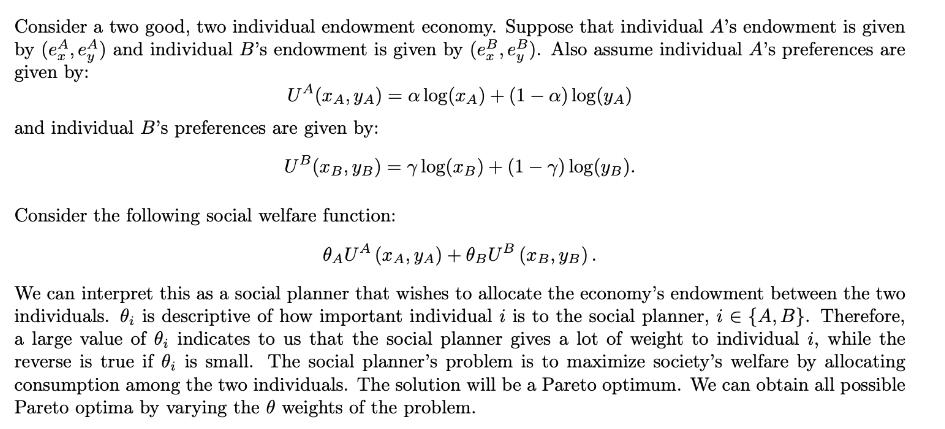Answered step by step
Verified Expert Solution
Question
1 Approved Answer
Consider a two good, two individual endowment economy. Suppose that individual A's endowment is given by (ee) and individual B's endowment is given by


Consider a two good, two individual endowment economy. Suppose that individual A's endowment is given by (ee) and individual B's endowment is given by (e, e). Also assume individual A's preferences are given by: UA (TA, YA) = a log(xA) + (1 - a) log(ya) and individual B's preferences are given by: UB (TB, YB) = y log(TB) + (1-7) log(YB). Consider the following social welfare function: OAUA (XA, YA) + OBUB (XB, YB). We can interpret this as a social planner that wishes to allocate the economy's endowment between the two individuals. 0, is descriptive of how important individual i is to the social planner, i E {A, B}. Therefore, a large value of 0; indicates to us that the social planner gives a lot of weight to individual i, while the reverse is true if 0, is small. The social planner's problem is to maximize society's welfare by allocating consumption among the two individuals. The solution will be a Pareto optimum. We can obtain all possible Pareto optima by varying the weights of the problem. 1. Write down the Planner's problem, as well as the Lagrangian. (Hint: There should be two constraints because aggregate consumption of each good cannot exceed the economy's endowment.) Label the multipliers and 2. [5 points] 2. What are the first order conditions of the Planner's problem? (Hint: There should be 6.). [5 points]
Step by Step Solution
★★★★★
3.42 Rating (152 Votes )
There are 3 Steps involved in it
Step: 1

Get Instant Access to Expert-Tailored Solutions
See step-by-step solutions with expert insights and AI powered tools for academic success
Step: 2

Step: 3

Ace Your Homework with AI
Get the answers you need in no time with our AI-driven, step-by-step assistance
Get Started


